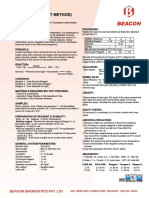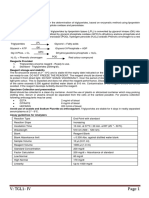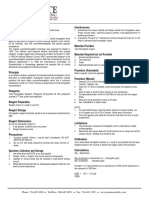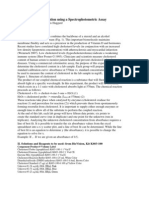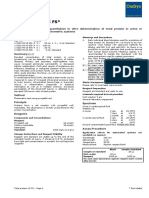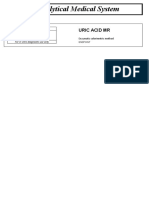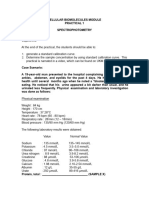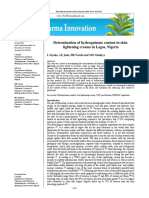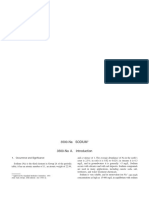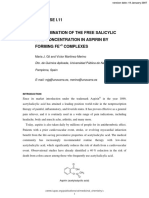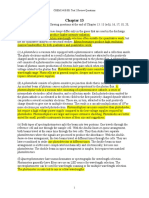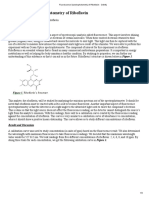C7510 01 2276
C7510 01 2276
Uploaded by
topurCopyright:
Available Formats
C7510 01 2276
C7510 01 2276
Uploaded by
topurOriginal Description:
Original Title
Copyright
Available Formats
Share this document
Did you find this document useful?
Is this content inappropriate?
Copyright:
Available Formats
C7510 01 2276
C7510 01 2276
Uploaded by
topurCopyright:
Available Formats
Cholesterol (Liquid)
Reagent Set
Intended Use Specimen Collection and Storage
For the quantitative determination of Total Cholesterol in serum. Nonhemolyzed serum is recommended. Cholesterol in serum is reported stable
for seven days at room temperature (18-25C) and six months when frozen and
Method History properly protected against evaporation.8,9
A Cholesterol method developed in the late 1800s by Lieberman1 and
Burchard2 is still in use today despite its corrosive nature and its Interferences
susceptibility to many interfering substances. A number of drugs and substances affect concentrations of cholesterol. See
Work on an enzymatic procedure was begun by Flegg3 and Richmond4 in the Young, et al.10
early 70s. Allain5 and Roeschlau6 began using cholesterol esterase and
oxidase, in a single reagent to determine total cholesterol in serum. Materials Provided
Trinders7 color system of peroxidase/phenol/4-aminoantipyrine has been Cholesterol Reagent.
used successfully for some time now. With appropriate calibrator value
assignment, this method has been shown to provide excellent accuracy in Materials Required but not Provided
relation to the reference methodology. 1. Accurate pipetting devices.
2. Timer.
Principle 3. Test tubes/rack
C. Esterase 4. Spectrophotometer with ability to read at 500 nm.
Cholesterol Esters -------------------------- Cholesterol + Fatty Acids 5. Heating Block (37C).
C. Oxidase Procedure (Automated)
Cholesterol + O2 ------------------------- Cholesterol-3-one + H2O2 Refer to specific instrument application instructions.
Peroxidase Procedure (Manual)
2H2O2 + 4-AAP + Phenol ------------------ Quinoneimine + 4 H2O
1. Label test tubes: Blank, Standard, Control, Patient, etc.
(red dye)
2. Pipette 1.0 ml of reagent into each tube and pre-warm at 37C for at least
five minutes.
The intensity of the red color produced is directly proportional to the total
3. Add 0.01 ml (10ul) of sample to respective tubes. Mix and return to 37C.
cholesterol in the sample when read at 500nm.
4. Incubate all tubes at 37C for five minutes.
5. Zero spectrophotometer with blank at 500nm.
Reagents 6. Read and record absorbances of all test tubes.
4-Aminoantipyrine 0.25mM, Cholesterol Esterase >150u/L, Cholesterol
Oxidase >150u/L, Peroxidase >1500u/L, Phenol >15mM, Phosphate Buffer, Procedure Notes
pH 6.8, non-reactive stabilizers and preservatives.
1. If the spectrophotometer being used requires a final volume greater than
1.0ml for accurate reading, use 0.025ml (25ul) of sample to 3.0ml of reagent.
Reagent Preparation Perform the test as described above.
The reagent is ready to use. 2. Grossly lipemic serums require a sample blank. Add 0.01ml (10ul) of
sample to 1.0ml saline, mix and read the absorbance against water.
Reagent Storage Subtract this value from the patient absorbance to obtain the corrected
1. Store reagent at 2-8C. reading.
2. The reagent is stable until the expiration date when stored at 2-8C.
Limitations
Reagent Deterioration Samples with values exceeding 500 mg/dl should be diluted 1:1 with saline and re-
Do not use if: run. The final answer should be multiplied by two.
1. The reagent is turbid.
2. The reagent does not meet stated performance parameters. Calibration
Aqueous standards can be used to calibrate the procedure or an appropriate
Precautions serum calibrator. The procedure should be calibrated according to the instrument
1. This reagent is for in vitro diagnostic use only. manufacturers instructions. If control results are found to be out of range, the
2. Not to be used internally in humans or animals. Normal precautions for procedure should be re-calibrated.
handling laboratory reagents should be followed.
3. Additional safety information concerning storage and handling of this Calculation
product is in the Material Safety Data Sheet for this product. Abs. = Absorbance
Abs. (Patient) x Concentration of Std. = Cholesterol (mg/dl)
Abs. (Standard) (mg/dl)
Cholesterol (Liquid)
Reagent Set
Example: Abs. (Patient) = 0.40, Abs. (Standard) = 0.32, Concentration of
Standard = 200 mg/dl
0.40 x 200 = 250 mg/dl
0.32
Quality Control
Serum controls with known normal and elevated values should be run
routinely to monitor the validity of the reaction. These controls should be run
at least with every working shift in which Cholesterol assays are performed.
It is recommended that each laboratory establish their own frequency of
control determination. Quality control requirements should be performed in
conformance with local, state, and/or Federal regulations or accreditation
requirements.
Expected Values11
Recommended Range:
Desirable Cholesterol: <200mg/dl
Borderline-High Cholesterol: 200-239mg/dl
High Cholesterol: >240mg/dl
Performance
1. Linearity: 500 mg/dl
2. Comparison: A comparison between this procedure and a similar dry
powder reagent produced a regression equation of y = 1.02x + 0.8 with
a correlation coefficient of 0.999.
3. Precision:
Within Run Run to Run
Mean S.D. C.V.% Mean S.D. C.V.%
157 1.1 0.7 155 1.3 0.8
224 1.7 0.8 227 2.4 1.1 Manufactured by Pointe Scientific, Inc.
5449 Research Drive, Canton, MI 48188
4. Specificity: Cholesterol oxidase is not totally specific for cholesterol.
Other analogs of cholesterol (dihydrocholesterol, 7-dehydrocholesterol, European Authorized Representative:
20-hydroxycholesterol, etc.) are also oxidized. These analogs do not Obelis s.a.
normally occur in any appreciable amounts in serum. Boulevard Gnral Wahis 53
1030 Brussels, BELGIUM
References Tel: (32)2.732.59.54 Fax: (32)2.732.60.03 email: mail@obelis.net
1. Lieberman, C., Ber. 18:1803 (1885).
2. Burchard, H., Chem. Fentr. 61:25 (1890).
3. Flegg, H.M., Ann. Clin. Biochem. 10:79 (1973).
4. Richmond, W., Scand. J. Clin. Lab. Invest. 29:Suppl. 26, abstr. 3:25
(1972).
5. Allain, C.C., et al, Clin. Chem. 20:470 (1974).
6. Roeschlau, P., et al, Z. Klin. Chem. Klin. Biochem 12:226 (1974). C7510 Manufactured by Pointe Scientific, Inc.
7. Trinder, P., Ann. Clin. Biochem. 6:24 (1969). 5449 Research Drive Canton, MI 48188
8. Perlstein, M.T., et al, J. Microchem. 22:403 (1977).
9. Witte, D.L., et al, Clin. Chem. 20:1282 (1974).
10. Young, D.S. et al, Clin. Chem. 21:1D (1975).
11. National Institute of Health Publication No. 88-2926 Detection,
Evaluation, and Treatment of High Cholesterol in Adults, November
(1987).
Rev. 5/17 P803-C7510-01
Use by (YYYY-MM-DD) Lot and batch code Catalog number Manufacturer In vitro diagnostic medical device
Temperature limitation Consult instructions for use CE mark Authorized representative in the European Community
You might also like
- URIC ACID LyphoDocument2 pagesURIC ACID LyphoDharmesh Patel50% (2)
- A Novel Method For Color Determination of Edible Oils in L A B FormatDocument9 pagesA Novel Method For Color Determination of Edible Oils in L A B Formatcyper zoonNo ratings yet
- AU400 Main Specifications and System OperationsDocument2 pagesAU400 Main Specifications and System OperationsSaleh HamadanyNo ratings yet
- C7510-01 - CholesterolDocument2 pagesC7510-01 - CholesterolSiva Kumar KNo ratings yet
- Pointe Scientific GOx G7521-01-934Document2 pagesPointe Scientific GOx G7521-01-934André CasillasNo ratings yet
- Budi-Cholesterol MR - Doc NewDocument3 pagesBudi-Cholesterol MR - Doc NewIrvanda ENVIOUSNo ratings yet
- Total Protein (Biuret) Reagent SetDocument2 pagesTotal Protein (Biuret) Reagent Setma_pacitarNo ratings yet
- Cholesterol: (Chod / Pod Method)Document2 pagesCholesterol: (Chod / Pod Method)psychejaneNo ratings yet
- Se120037bul Kit KortisolDocument3 pagesSe120037bul Kit KortisolSuhardi AtmokoNo ratings yet
- Cholesterol SLR INSERTDocument1 pageCholesterol SLR INSERTventasmedicarescNo ratings yet
- Glucose Meron KitDocument2 pagesGlucose Meron KitRanjit PathakNo ratings yet
- Uric AcidDocument2 pagesUric AcidJM GarcesaNo ratings yet
- 10.total CholesterolDocument2 pages10.total Cholesteroltuan vănNo ratings yet
- DOC316.53.01033 10edDocument6 pagesDOC316.53.01033 10edRichard Ivan Medina HoyosNo ratings yet
- 11505IDocument1 page11505ITrần Tiến ĐạtNo ratings yet
- UREA Berthlot PDFDocument1 pageUREA Berthlot PDFDiegoNo ratings yet
- ALBUMIN+Std BM ANG 2015 02 03Document2 pagesALBUMIN+Std BM ANG 2015 02 03yehiwal756No ratings yet
- Triglycerides: (Gpo - POD Method)Document2 pagesTriglycerides: (Gpo - POD Method)Ranjit PathakNo ratings yet
- HDL Precipitant 2Document7 pagesHDL Precipitant 2Nur IndahNo ratings yet
- T7528-01 - Total ProteinDocument2 pagesT7528-01 - Total ProteinSiva Kumar KNo ratings yet
- Hemoglobin PDFDocument6 pagesHemoglobin PDFMega Devega ArvianyNo ratings yet
- Total ProteinDocument2 pagesTotal ProteinDina FarghalyNo ratings yet
- Cycle 3 Day3Document4 pagesCycle 3 Day3Nikki Anne AmbataNo ratings yet
- Cromo Hexa 8023 433Document6 pagesCromo Hexa 8023 433Wilson NaranjoNo ratings yet
- 1.alpha AmylaseDocument2 pages1.alpha AmylaseHiếu Chí PhanNo ratings yet
- Cholesterol Reagent: Symbols in Product Labelling Product SummaryDocument2 pagesCholesterol Reagent: Symbols in Product Labelling Product SummaryPaul TuveraNo ratings yet
- PI e CHOL - 5 7Document2 pagesPI e CHOL - 5 7Salsabila Nur OktavianiNo ratings yet
- Citric AcidDocument1 pageCitric Acidasifiqbal140No ratings yet
- 1115000I Rev. 03 - 2Document2 pages1115000I Rev. 03 - 2kirubel demelashNo ratings yet
- AlcoholDocument1 pageAlcoholtuan vănNo ratings yet
- Glo2 Glucose Ox LiqDocument4 pagesGlo2 Glucose Ox LiqInversiones Llanolab, c.a. LlanolabNo ratings yet
- HDL PresipitantDocument2 pagesHDL PresipitantDidik PrasetyaNo ratings yet
- 1118005I Rev. 02Document2 pages1118005I Rev. 02BalesheNo ratings yet
- Assay Guidelines For Manual Procedure Reagents Blank Standard SampleDocument1 pageAssay Guidelines For Manual Procedure Reagents Blank Standard SampleRanjit PathakNo ratings yet
- CALCIUM CPC+STD ANG 2015 02 17Document2 pagesCALCIUM CPC+STD ANG 2015 02 17yehiwal756No ratings yet
- 35.mucoproteinsDocument2 pages35.mucoproteinsHiếu Chí PhanNo ratings yet
- Albumin Asritha 2X50 MLDocument1 pageAlbumin Asritha 2X50 MLN. K. MandilNo ratings yet
- Cholesterol Quantification Using A Spectrophotometric AssayDocument3 pagesCholesterol Quantification Using A Spectrophotometric AssayAlisa LimNo ratings yet
- 11503I GlucoseDocument1 page11503I GlucosemahinNo ratings yet
- Generic Name: High Sensitivity C-Reaction Protein Kit Abbreviated name:HS-CRP Order InformationDocument36 pagesGeneric Name: High Sensitivity C-Reaction Protein Kit Abbreviated name:HS-CRP Order InformationSharom Zelene Cordova RomanNo ratings yet
- Colesterol SLDocument4 pagesColesterol SLLUIS DANIEL VAZQUEZ RAMIREZNo ratings yet
- E BC K145 S ElabscienceDocument12 pagesE BC K145 S ElabscienceMohammedNo ratings yet
- AAT2 enDocument3 pagesAAT2 enSyahdie FahledieNo ratings yet
- MEASURE HbA1c (Fixed)Document2 pagesMEASURE HbA1c (Fixed)Trần Văn Bình100% (1)
- Creatinine (Alkaline Picrate) PDFDocument1 pageCreatinine (Alkaline Picrate) PDFatul pandey100% (1)
- Pointe Calcium InsertDocument2 pagesPointe Calcium InsertosvaldoveronaNo ratings yet
- Chol PDFDocument1 pageChol PDFTaqien AbscNo ratings yet
- PI e CHOL - 5 11Document2 pagesPI e CHOL - 5 11ahmadjaffal2003No ratings yet
- EN - TOTAL PROTEIN - BAOSR6x32 - USDocument3 pagesEN - TOTAL PROTEIN - BAOSR6x32 - USDharmesh PatelNo ratings yet
- Albumin Liquicolor: Photometric Colorimetric Test For Albumin BCG-MethodDocument1 pageAlbumin Liquicolor: Photometric Colorimetric Test For Albumin BCG-MethodMaher100% (1)
- Total - Protein Meron KitDocument2 pagesTotal - Protein Meron KitRanjit PathakNo ratings yet
- PI e TPU 11Document2 pagesPI e TPU 11Sinari AlfatNo ratings yet
- GPL Cholesterol LyoDocument2 pagesGPL Cholesterol LyoGhost IraQNo ratings yet
- Budi Uricacidmr NewDocument3 pagesBudi Uricacidmr NewIrvanda ENVIOUSNo ratings yet
- PI e LDLC - PRECIP 5Document2 pagesPI e LDLC - PRECIP 5Rizki Dyah RahmawatiNo ratings yet
- GA4710 00-Total ProteinsDocument2 pagesGA4710 00-Total ProteinsTrần Thanh ViệnNo ratings yet
- CholesterolDocument2 pagesCholesterolAmmar MostafaNo ratings yet
- Human Interleukin 1, IL-1 ELISA KitDocument8 pagesHuman Interleukin 1, IL-1 ELISA KitAkanksha SinghNo ratings yet
- CH200Document4 pagesCH200infocarol2017No ratings yet
- Euro CRP TurbilatexDocument2 pagesEuro CRP TurbilatexDharmesh Patel100% (1)
- 1105000I Rev. 02Document2 pages1105000I Rev. 02Riadh BenyoucefNo ratings yet
- Extraction and Determination of Anthocyanin Pigment From Hibiscus Sabdariffa Calyx by The Use of Uv and HPTLC MethodDocument6 pagesExtraction and Determination of Anthocyanin Pigment From Hibiscus Sabdariffa Calyx by The Use of Uv and HPTLC MethodSamira NjifenjouNo ratings yet
- Practical 1Document7 pagesPractical 1ARYSSA BINTI AZRINo ratings yet
- Spectrophotometric Determination of Available Sulphate Content in Soil Samples of Jaipur DistrictDocument3 pagesSpectrophotometric Determination of Available Sulphate Content in Soil Samples of Jaipur DistrictGRD JournalsNo ratings yet
- DMA-80 Application Book PDFDocument168 pagesDMA-80 Application Book PDFSergio MaquilónNo ratings yet
- Determination of Hydroquinone Content in Skin-Lightening Creams in Lagos, NigeriaDocument5 pagesDetermination of Hydroquinone Content in Skin-Lightening Creams in Lagos, NigeriaftmrdrNo ratings yet
- 3500 Na SODIODocument3 pages3500 Na SODIOCecilia AvilaNo ratings yet
- A Practical Handbook of Seawater AnalysisDocument328 pagesA Practical Handbook of Seawater Analysisfdlab100% (2)
- Measurement Method: Measuring Loose PowderDocument4 pagesMeasurement Method: Measuring Loose Powderdéborah_rosalesNo ratings yet
- Densitometry and Spectrophotometr Y: Spectrophotometer ResponseDocument3 pagesDensitometry and Spectrophotometr Y: Spectrophotometer ResponseDiego FrancoNo ratings yet
- EDTA + CobreDocument3 pagesEDTA + CobreKaue AraujoNo ratings yet
- Uv Visible SpectrosDocument28 pagesUv Visible Spectrosjoshishravan3003No ratings yet
- Aashto T 250 PDFDocument13 pagesAashto T 250 PDFHsaam HsaamNo ratings yet
- 102 Protole 20mg CapDocument6 pages102 Protole 20mg CapLife PearlNo ratings yet
- Measuring Manganese Concentration Using SpectrophotometryDocument8 pagesMeasuring Manganese Concentration Using SpectrophotometryCuprum29No ratings yet
- Data ColorDocument95 pagesData ColorArifZamanNo ratings yet
- Global Tekno - Company ProfileDocument24 pagesGlobal Tekno - Company Profilegd sutawijayaNo ratings yet
- Determination of The Free Salicylic Acid Concentration in Aspirin by Forming Fe3+ ComplexesDocument8 pagesDetermination of The Free Salicylic Acid Concentration in Aspirin by Forming Fe3+ Complexes黎曼菲No ratings yet
- Practice 2: Protein Quantification Biochemistry Pharmaceutical IPNDocument12 pagesPractice 2: Protein Quantification Biochemistry Pharmaceutical IPNScribdTranslationsNo ratings yet
- Vitamin C (VC) Colorimetric Assay Kit: 8th Edition, Revised in February, 2018Document5 pagesVitamin C (VC) Colorimetric Assay Kit: 8th Edition, Revised in February, 2018SeftiyantiNo ratings yet
- CL-50 Plus Product Brochure-TADocument2 pagesCL-50 Plus Product Brochure-TATrình BiomedicNo ratings yet
- Study Guide CHEM 3418 Test 2Document23 pagesStudy Guide CHEM 3418 Test 2Morgan SobolNo ratings yet
- A Review On Reference StandardsDocument12 pagesA Review On Reference StandardsjyothiNo ratings yet
- Technical Product Information: Color Matching SoftwareDocument4 pagesTechnical Product Information: Color Matching SoftwareAddul Omman NailNo ratings yet
- Martin L. Price, Et Al. 1977Document6 pagesMartin L. Price, Et Al. 1977Génesis Ester Pérez CanNo ratings yet
- Resume 4 Food Analysis - Group 5Document4 pagesResume 4 Food Analysis - Group 5Queena Fatima AzzahraNo ratings yet
- Shimadzu Spectrophotometer UV-1900Document18 pagesShimadzu Spectrophotometer UV-1900Cristian VergaraNo ratings yet
- Discussion Uv VisDocument4 pagesDiscussion Uv VisFatin ArisyaNo ratings yet
- Fluorescence Spectrophotometry of Riboflavin - OdinityDocument4 pagesFluorescence Spectrophotometry of Riboflavin - OdinityKariEspinozaNo ratings yet















